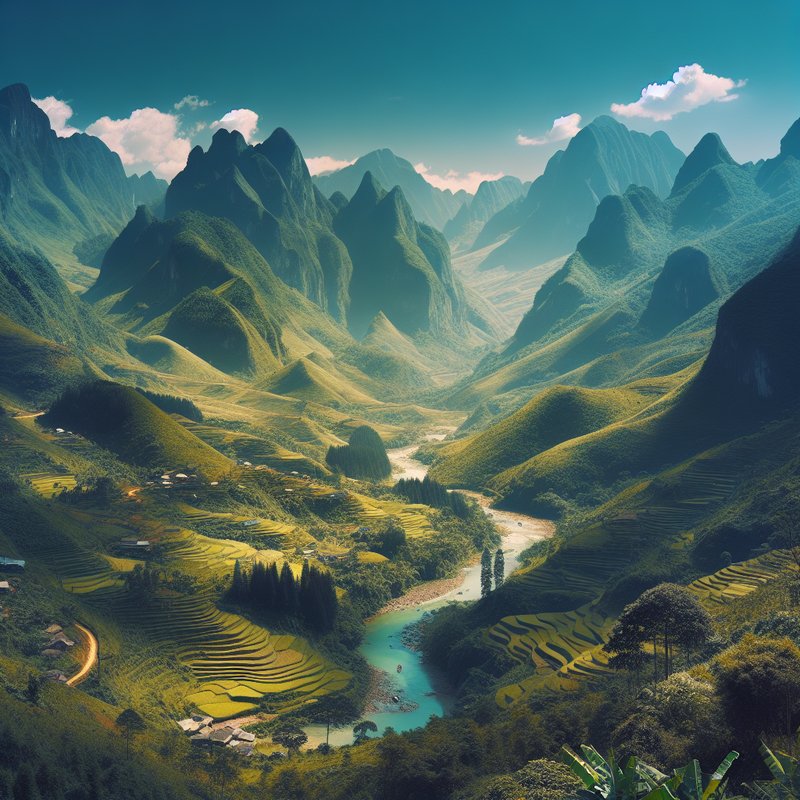The Majestic Landscapes of Sapa

Sapa, located in the northwest of Vietnam, is renowned for its stunning terraced rice fields, which change color with the seasons. During the spring, the fields are a vibrant green, and as the summer progresses, they turn a lush, deep green. Come autumn, the fields are golden, with ripe rice ready for harvest, creating a visual spectacle that attracts photographers and travelers from around the world. Surrounding these terraced fields are dramatic mountain vistas, often shrouded in mist, adding to the enchanting beauty of the region. This blend of agricultural artistry and natural splendor makes Sapa’s landscapes truly breathtaking.
In addition to its breathtaking landscapes, Sapa offers rich cultural experiences. The region is home to various ethnic minority groups such as the Hmong, Dao, Tay, and Giay, each with their own distinct traditions and customs. These communities are known for their vibrant attire, intricate embroidery, and colorful festivals that reflect their cultural heritage. Visitors to Sapa can explore the bustling local markets, where artisans sell handmade crafts including textiles, jewelry, and wooden carvings. These markets not only provide a glimpse into the daily lives of the local people but also offer unique souvenirs that capture the essence of Sapa’s cultural diversity.
Adventures in Ha Giang

Ha Giang is known for its rugged terrain and remote villages. This paragraph takes readers on a journey through the winding mountain roads, offering exhilarating motorbike rides and beautiful scenic views at every turn.
Aside from the thrill of adventure, Ha Giang is also a place of tranquility and cultural immersion. Visitors to Ha Giang can partake in homestays with local families, offering a unique opportunity to experience the region’s rich cultural tapestry first-hand. These homestays provide travelers with an intimate glimpse into the daily lives of the indigenous people, their customs, and their traditions. Guests can engage in various activities such as traditional cooking, farming, and handicraft-making, fostering a deeper connection and understanding of the local way of life. This culturally immersive experience not only enriches the visitor’s journey but also supports the local communities economically and socially.
The Charm of Mai Chau

Mai Chau, a rural district in Hoa Binh province, stands out for its idyllic scenery and calm atmosphere. The region is characterized by its lush valleys, dotted with traditional stilt houses that belong to the local ethnic Thai people. Misty mountains surround these valleys, creating a serene and picturesque landscape that is perfect for relaxation and unwinding. The friendly local population adds to the charm of Mai Chau, often welcoming travelers into their homes and sharing stories about their customs and traditions. It’s an ideal destination for those looking to escape the hustle and bustle of city life and enjoy a peaceful retreat immersed in nature.
Mai Chau is an excellent destination for those who enjoy outdoor activities like cycling and hiking. These activities offer a fantastic way to explore the region’s beautiful countryside, characterized by lush green valleys, scenic rice paddies, and picturesque stilt houses. Cycling through the quaint villages not only allows visitors to soak in the serene landscape but also provides ample opportunities to interact with the locals. The White Thai people, known for their warm hospitality, often invite travelers into their homes, offering a firsthand experience of their traditional lifestyle. This cultural exchange adds a profound dimension to the travel experience, making it far more enriching and memorable.
Exploring the Diverse Flora and Fauna

Vietnam’s mountainous regions are not only culturally rich but also biologically diverse. These high-altitude areas are home to unique flora and fauna that thrive in the cooler climates and rugged terrain. Visitors can encounter rare and endangered species, such as the Tonkin snub-nosed monkey, which is native to these remote forests. Additionally, the lush vegetation includes a vast array of plant life, from ancient pine trees to colorful orchids, creating a vibrant ecosystem that is both fascinating and vital for biological research.
Protected areas and national parks play a crucial role in preserving the biodiversity of Vietnam’s mountainous regions. Efforts to conserve these natural habitats are multifaceted, involving both government initiatives and local community involvement. These areas are managed to ensure the protection of rare and endangered species while maintaining the natural landscape. One of the key strategies to support conservation is the promotion of eco-tourism. By encouraging responsible travel practices, visitors can appreciate the natural beauty of the highlands without causing harm to the environment. Eco-tourism initiatives often include guided tours, educational programs, and sustainable lodging options that minimize environmental impact. This approach not only helps in conserving the biodiversity but also provides economic benefits to local communities, creating a win-win situation for nature and people alike.

Leave a Reply